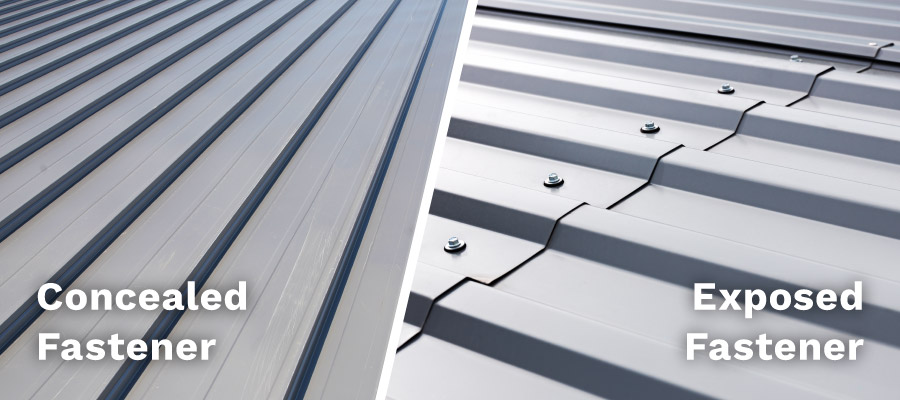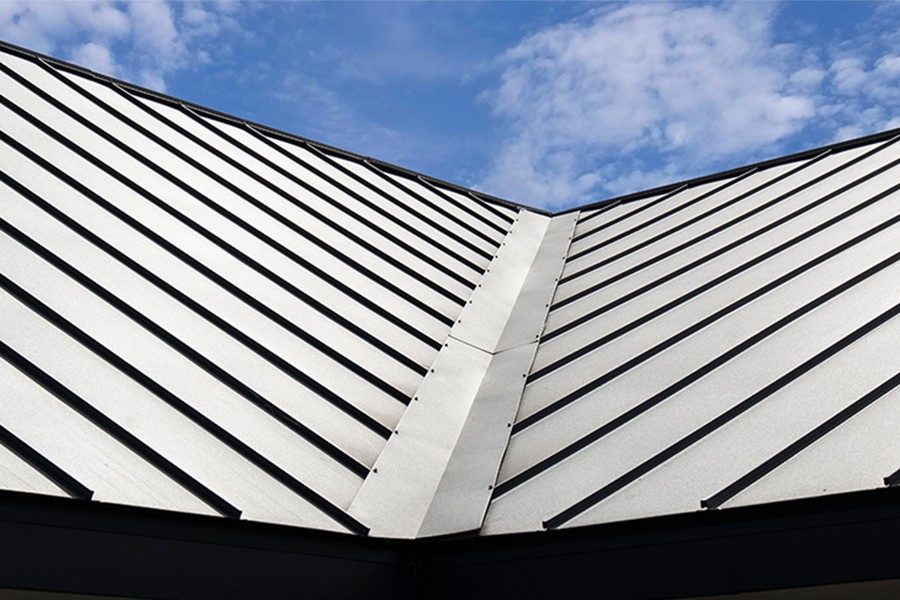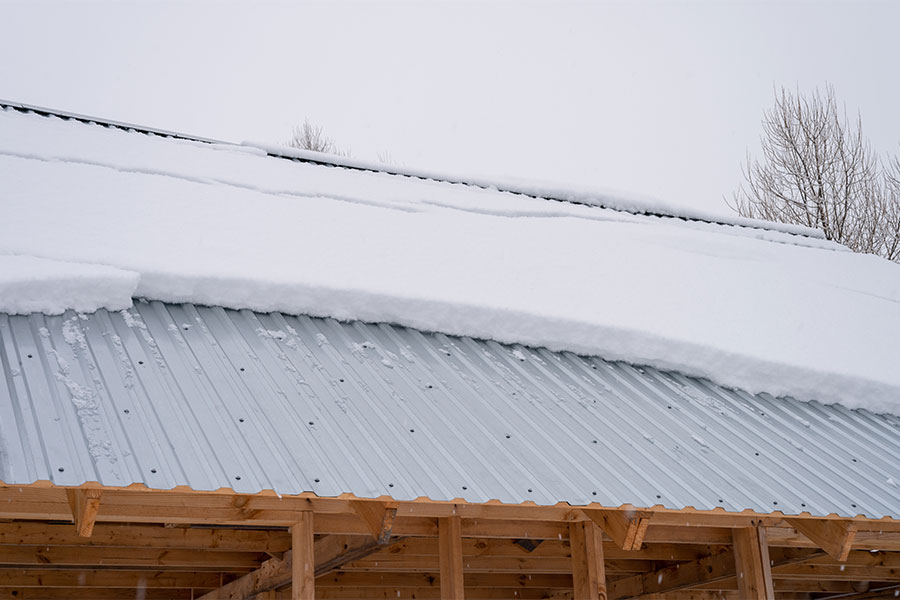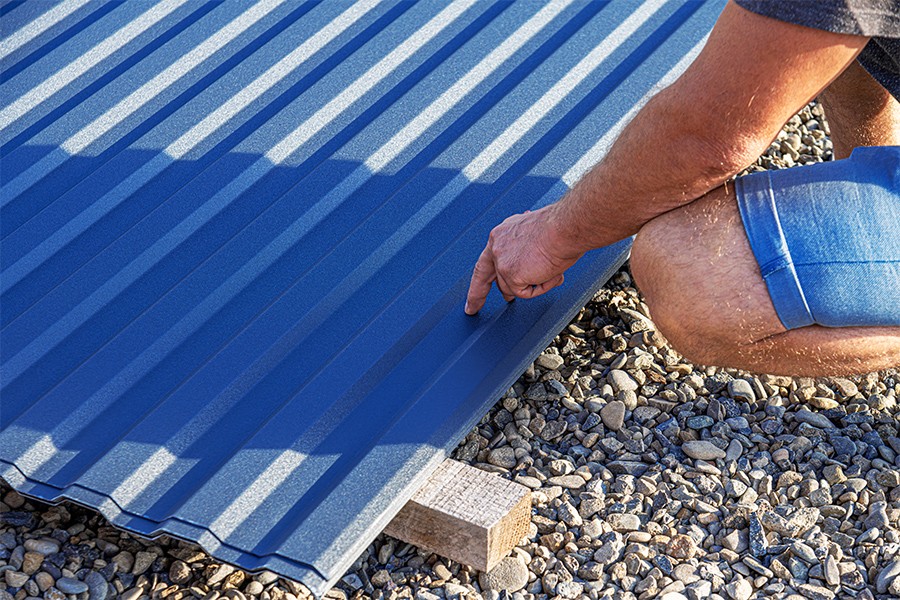There’s no doubt about the merits of metal roofing systems. Durable, aesthetically pleasing, and incredibly long-lasting, metal panels offer many rewards to property owners across Montana. But did you know even the type of connection strategy used to fasten a panel has unique benefits?
Concealed and exposed fastener panels are the main types of connection strategies used for metal roofs, and each has unique advantages and challenges. Today, we’re breaking down the key differences between concealed and exposed fastener panels. At the end of this blog, you’ll be fully equipped to select the connection strategy that’s best for your roofing and siding needs. Let’s dive in!
What are Concealed and Exposed Fastener Panels?
The terms “concealed” and “exposed” refer to the type of fastening system each panel type uses. Concealed fastener metal roofing uses fasteners that are hidden beneath the roofing surface so you do not see the fastener. Conversely, exposed fastener metal roofs have visible fasteners. These fasteners directly penetrate the panel to secure it to the roof deck.

What are the Differences Between Concealed and Exposed Fastener Panels?
Due to the differences in connection strategies, concealed and exposed fastener panels have distinct benefits and obstacles. Your choice between these panel types depends on your goals and property needs. You’ll need to take into account each panel type’s unique characteristics when making a decision. Overall, the differences between the two panel types come down to aesthetics, installation, maintenance, and cost.
Aesthetics of Concealed and Exposed Fastener Panels
Concealed Fastener Panels
Concealed fastener panels hide the presence of screws that can disrupt the overall, cohesive look of a roofing system. The absence of visible fasteners helps create a smooth, uniform finish to onlookers, lending to this panel’s visual appeal. Buildings with contemporary architectural designs often opt for concealed fastener panels to create a sleek, stylish look.
Exposed Fastener Panels
The visible screws on exposed fastener panels don’t diminish their aesthetic appeal but do give them a more industrial, traditional feel. Some people choose exposed fastener panels for rustic or agricultural building designs, as the exposed fasteners lend to an overall honest, classic look.
Panel Installation Considerations
Concealed Fastener Panels
Installing concealed fastener panels requires close attention to detail, adherence to slope best practices, and trained skill. Firstly, concealed fasteners perform better on lower roof slopes, so considerations for this must be taken into account before selecting concealed fastener panels for a project. Secondly, each panel must be correctly aligned and measured to ensure that the fasteners are hidden and securely attached. Installers use clips or fasteners that attach to the underlying structure or the adjacent panels. This allows the panels to move slightly with temperature changes without causing damage. The precision required for this installation means you not only need skilled installers but also extra installation time. However, if done accurately, the end result is a clean, streamlined roofing appearance.
Exposed Fastener Panels
Exposed fastener panels are generally straightforward and quick to install. These panels are fastened directly through the panel and into the roof deck or frame below using screws. These screws remain visible on the surface of the panel, so there are no additional steps needed to conceal them. Because of this, this method does not require added technical skill or specialized tools as with concealed fasteners.
Maintenance & Upkeep of Panels
Concealed Fastener Panels
Concealed fastener panels have a clear advantage in maintenance and durability because of their design. The fasteners are tucked away under the metal sheets, shielding them from rain, snow, and sun. This protection means the fasteners don’t wear out as quickly. They’re less likely to rust or break compared to those on exposed fastener panels. Additionally, concealed fastener panels are better able to withstand the forces of thermal expansion and contraction compared to exposed fastener panels. Since the fasteners are not exposed to the changing temperatures, they are less prone to loosening, which often leads to leaks in roofs with exposed fasteners. Overall, this makes concealed fastener panels a more durable and low-maintenance choice, requiring fewer checks and repairs for issues related to the fasteners.
Exposed Fastener Panels
Unlike concealed fastener panels, the screws on exposed fastener panels can eventually need replacement. Because these screws are exposed to the elements, they experience more wear and tear. These screws typically have rubber washers at the base to help seal out water. But, over time, these washers can degrade, and the screws can loosen due to the natural expansion and contraction of the metal. This can lead to potential leaks over time. Because of this risk, exposed fastener systems often require periodic maintenance to retighten loose screws and replace worn washers to ensure the roof remains watertight.
Cost of Concealed Fastener Panels vs Exposed Fastener Panels
Concealed Fastener Panels
Concealed fastener panels typically come with a higher initial price tag. The materials often used in these panels are usually of higher quality (thicker gauge), lending to a higher price. Additionally, the installation process is more labor-intensive because of the precise placement and special equipment needed. Despite the upfront cost, the investment is worth it. As previously mentioned, these panels provide a tighter seal against harsh weather, significantly reducing the risk of leaks. Their robust construction also tends to have greater durability, which can mean fewer repairs and replacements over the roof’s lifespan. This can make concealed fastener panels a more cost-effective option over many years.
Exposed Fastener Panels
Exposed fastener panels are generally more budget-friendly at the outset. They require less specialized labor for installation, which can significantly lower initial costs. The installation process is also usually quicker, reducing labor costs even further. However, these cost benefits can be somewhat offset by increased long-term maintenance. As we mentioned earlier, exposed fasteners are more susceptible to the elements, which can lead to issues like corrosion or loosening over time. Regular maintenance is required to tighten or replace fasteners and ensure the integrity of the roof. This can add to the overall cost of upkeep.
Get Started with Great Northern Metal Company
Deciding between concealed and exposed fastener panels depends on your specific needs, budget, and aesthetic preference. If you’re ready to discuss which option is best for your project, reach out to us at Great Northern Metal Company. As Bozeman roofing experts, we’re here to provide in-depth advice and quality materials that fit your project’s demands. Our team goes above and beyond to understand your goals and specifications to ensure you’re matched with the best materials for your needs. Contact us today for a consultation or quote—let’s build something great together!


